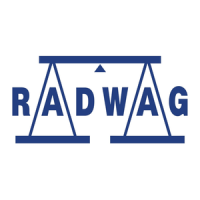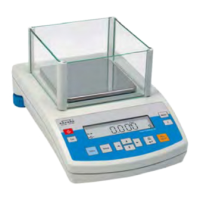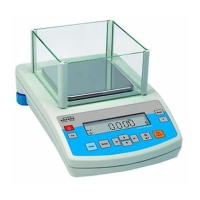
Do you have a question about the RADWAG PS 4500.R2 and is the answer not in the manual?
| Maximum Capacity | 4500 g |
|---|---|
| Readability | 0.01 g |
| Display | LCD |
| Repeatability | 0.01 g |
| Linearity | ±0.02 g |
| Stabilization Time | 2 s |
| Adjustment | Internal |
| Protection Class | IP 43 |
| Operating Temperature | +10°C to +40°C |
| Interface | RS232 |
Provides technical specifications for XA, AS, PS, and APP balance series, including capacity, readability, and dimensions.
Describes the physical ports for connecting peripherals like printers and computers.
Specifies intended purpose, lists prohibited uses, and outlines warranty conditions.
Provides guidelines for safe transport, storage, and delivery checks.
Details balance placement requirements and assembly steps.
Guides on unpacking, leveling the balance, and cleaning its components.
Instructions for connecting power and additional peripherals.
Guides on connecting devices and ensuring thermal stability before operation.
Explains how to move through and interact with the balance's menu system.
Details initial login, user management, and access level configurations.
Essential procedures for zeroing the balance and performing tare operations.
Allows setting parameters like filtering, autozero, and units for the weighing mode.
Introduces and guides on using counting, checkweighing, and dosing functions.
Explains procedures for density determination and pipette calibration.
Configures menu language, user access, display brightness, and time/date formats.
Performs an automated test to ensure balance accuracy and diagnose issues.
Details automatic and manual internal calibration methods to ensure accuracy.
Guides on performing external calibration using weights and user-defined adjustments.
Describes how to generate and print reports for adjustment processes.
Configures data included in headers, footers, and measurement result printouts.
Allows creating custom printouts and inserting variables or static text.
Manages user accounts, product data, and associated parameters.
Stores tare values and automatically logs weighment data for audits.
Stores a large volume of measurements for audit trail purposes.
Guides on archiving or transferring database contents to external memory.
Saves measurement data to a PENDRIVE in a text file format.
Configures which weighing modes are accessible to the user.
Explains using counting parts and checkweighing modes with reference mass and thresholds.
Covers dosing, deviation calculations against standards, and animal weighing.
Details procedures for density determination and pipette calibration.
Configures serial (RS232) and wireless (Wi-Fi) communication parameters.
Sets up parameters for connecting computers and printers via various ports.
Configures peripherals like bar code readers, displays, and external buttons.
Illustrates cable connections and defines data transmission formats for peripherals.
Lists and details commands for controlling the balance via RS232 interface.
Explains the formats of responses to computer commands and their meanings.
Describes optional accessories like anti-vibration tables, density kits, and additional displays.











